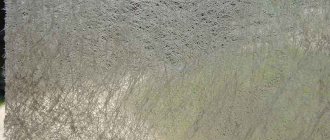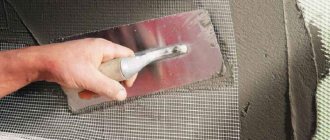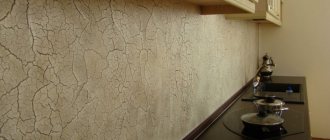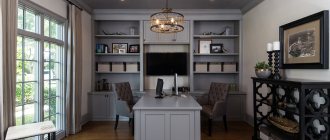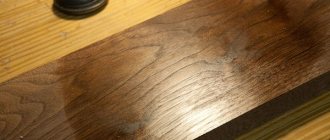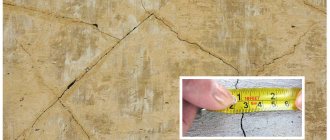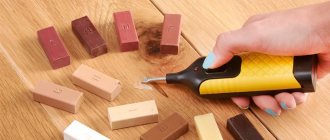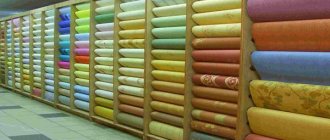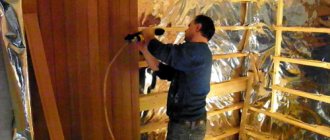Painting fiberglass canvas is a popular option for fiberglass repair and finishing materials. You can recall another similar material, the so-called fiberglass wallpaper - but this is a ready-made finishing coating and is suitable for smooth walls. And if the walls need to be leveled and cracks removed, then fiberglass web can handle this better and faster than plaster. This is a thin (25–50 g/sq. m), opaque and pliable canvas, which, thanks to its texture, perfectly strengthens and levels the walls before painting.
Why do you need fiberglass web?
Fiberglass web as a new generation material meets modern requirements for wall repairs. In addition to good plastering properties, fiberglass sheeting creates a reinforced, non-destructive layer on which you can paint or wallpaper. And this, unlike a number of plastering and painting works, is done quickly - by gluing it to the wall.
The finished result is a smooth surface: textureless, rough, resistant to moisture and mechanical damage, environmentally friendly, breathable and fireproof. And, most importantly, durable - it can be repainted again and again if desired.
Painting fiberglass web application: how to paint
If you decide to paint the canvas, then we recommend using water-based paint for such a surface. Such paint will retain the properties of the finishing material itself and, moreover, more than one layer of paint can be laid on it in an even layer.
Using painting fiberglass, how to paint correctly video
For painting you will need the following tools:
- a tray where the paint will be poured;
- a roller, preferably with a thread-type pile (you can use a paint brush, but then the painting process will take a long time).
It is necessary to paint the fiberglass spider web twice, that is, apply two layers of paint. It is worth noting that the time between applying layers should be at least 12 hours. To roll a seam, you need to use a “wing”; if you do it with a roller, the result will not be optimal. In principle, these are all the features of painting such a finishing material.
Where can it be used?
Manufacturers recommend fiberglass web fabric for already plastered walls and ceilings, or lined with plasterboard. Fiberglass can be successfully replaced with finishing putty. Especially on surfaces prone to cracking, the web will prevent cracking and the formation of damage and flaws - that is, all those imperfections that we usually see on walls prepared without fiberglass layers.
The use of cobwebs is relevant when walls need additional reinforcement and strength without increasing the load. And also if it is necessary to hide the joints between slabs, in particular, plasterboard (which, when stored in a warehouse, absorb excess moisture and become deformed when drying).
It is advisable to use cobwebs in new buildings: it prevents defects in walls and ceilings that form after shrinkage, greatly simplifies the maintenance of surfaces and guarantees their long-term use.
Due to its properties, fiberglass is excellent in rooms with high humidity: kitchens, bathrooms, plumbing rooms.
The material can also be used for roofing, strengthening walls, protecting pipelines, waterproofing and design purposes.
Is it possible to glue wallpaper onto fiberglass webs?
To begin with, I would like to say that painting fiberglass is a material that serves to reinforce surfaces, and it is glued to secure plaster, putty, and also to avoid the appearance of cracks on the walls. This material is excellent for painting.
As for wallpaper, in the case of fiberglass, you can glue it, but before that you will have to treat the surface of the wall or ceiling, and only then start gluing the wallpaper onto the surface.
Since painting fiberglass web, the use of which is a protection against cracks, is not a finishing coating, it can be either painted or glued on top of wallpaper, but after first treating the surface.
If the gluing process seems difficult to you and somewhat incomprehensible, then we recommend that you watch the video on our website, which describes in detail and shows how to properly glue fiberglass webs to various surfaces.
Why do they prefer fiberglass: the advantages
It is worth buying fiberglass from a specific manufacturer if the description of the material contains the advantages described below. For example, fiberglass web "Vitrulan" made in Germany is environmentally friendly and recommended for use in children's and health care institutions. It can be guaranteed to be used for painting - unlike other brands, Vitrulan does not act as a rough surface beyond the paint layer.
The practice of using fiberglass web shows that it has:
- Resistant to moisture accumulation - this is evidenced by water-repellent properties.
- Resistant to damage - the surface cannot be scratched or punctured.
- Fire safety - fiberglass materials do not ignite.
- Reinforcing ability - the fibers of the fabric, after gluing it to the surface, do not stretch and create a monolithic layer.
- Environmentally friendly - fiberglass web consists of substances that are involved in the production of glass, therefore it does not contain harmful compounds, is not an allergen, and does not enter into chemical reactions with the environment.
- Vapor-air permeability - the canvas “breathes”, that is, it allows air and steam to pass through, preventing the development of mold and mildew, and waterlogging of the premises.
Fiberglass is convenient to transport and work with: the web is sold in rolls of a meter wide and optimal (20 and 50) lengths.
How to properly glue painting fiberglass
In order to stick the material on the walls or ceiling, you do not need to have any special skills or knowledge. You just have to find out how it's done and get to work. If you don’t want to pay a lot of money to craftsmen for a fairly simple finishing process, then just follow the recommendations that will help you do everything correctly and quickly.
How to glue fiberglass webs with putty onto drywall video
- To begin with, glue is applied to the surface of the ceiling or walls; you don’t need to apply a lot; it will be enough to apply glue one strip wide. The substance is absorbed quickly enough, so there is no need to remove it from under the finishing material.
- There are no standards for the width of the strips, you can cut them as you wish, the main thing is that it is convenient to work with them. With the finishing of the walls everything will be simpler, so you can cut the strip to its full length, but for the ceiling a strip of one and a half to two meters will be enough. Before gluing, check where the front and back sides are. They look very similar, but there is a difference in them, so you will find all the necessary information about this on the label.
- Painting fiberglass canvas: the use of which is suitable for all surfaces in the room, and even for plasterboard structures, after fitting to the wall, it is smoothed out carefully with your hands. You need to make sure that the corner of the room coincides with the edge of the web. After that, it is necessary to run a spatula over the surface so that no air remains under the coating.
- When the sheet is firmly attached to the wall, you can start cutting off all the excess that sticks out or hangs. Then apply glue to the surface again. To understand that the sheet is well soaked, it should become dark from moisture.
- We glue the next sheet, the same size as the previous one, to the wall, making sure to overlap. If the material is glued to the ceiling, then it is better to glue it along the room.
Price for cobweb for repairing walls for painting
Prices for cobwebs per roll 1m x 50m, i.e. for 50 squares from 278 rubles. per roll.
At its low price, fiberglass web creates all the conditions for savings: there is no need for costly rough finishing and plastering work. The cost depends on the density of the canvas and its length in the roll.
In any case, this is an ideal option for developers and renovation customers who want to get an effective result quickly.
Photo ideas in the interior
For the bathroom
Fiberglass wallpaper will be a good finishing option for a bathroom. They are not afraid of moisture and will not allow fungus and mold to appear.
For greater strength and reliability, the fiberglass fabric is coated with washable paint.
For kitchen
A big advantage can be considered the high fire resistance of glass wallpaper.
In the kitchen, this fact is very relevant. At high temperatures, fiberglass sheets do not emit harmful substances. In addition, replacing glass wallpaper will cost less and the work will be easier. Suitable for finishing the dining area.
In the toilet
In the toilet, as well as in the bathroom, it is important to minimize the possibility of mold and mildew. Fiberglass wallpaper will help with this; they will be a good alternative to tiles. In addition, their cost is lower than tiles.
In the hall
The strength of the fiberglass material will eliminate mechanical damage to the surface, and the waterproof coating is easy to care for and keep clean.
On the balcony
Fiberglass wallpaper is not afraid of changes in temperature and humidity; it will be a practical solution for finishing a glazed balcony or loggia.
Choosing glue for web
Traditional PVA glue is not suitable for gluing fiberglass materials - yellow spots may appear on the surface of the coating. It is necessary to use a special glue; the recommended one offers customers its own special glues and other related products.
You need to buy glue with a reserve, counting on higher consumption compared to regular wallpaper. Dilute according to the instructions, taking into account the proportions - not thicker or thinner than recommended, and then there will be no unexpected surprises.
Qualities and advantages
The technical features of the product and its advantages were determined by professionals and ordinary buyers.
Environmental friendliness
When it comes to high-quality wallpaper, manufacturers use exclusively safe and natural raw materials. Due to this characteristic, the finish can be used to decorate children's rooms, as well as in houses where allergy sufferers live.
This is a significant advantage compared to products made from artificial substitutes and chemical components.
Special texture
Fiberglass wallpaper is a breathable material. Due to the air permeability, comfortable conditions are created in the room. Excess moisture, which causes the formation of fungus and bacteria, does not accumulate under and on the finish.
Antistatic
Due to its special composition, wallpaper does not accumulate an electrical charge, since glass does not conduct electricity. Thanks to the special effect, the cleaning process is much easier, because dust practically does not accumulate on the surface. This is also a plus from an aesthetic point of view.
Reliability and durability
The glass fiber material boasts its durability. The service life of the canvas is many times greater than that of wallpaper made from other materials, such as paper or fabric. On average it lasts about 30 years.
Wallpaper is also practical and wear-resistant, does not require special care, and is not susceptible to damage from the paws of pets or a bicycle.
Fire resistance
Fire safety is very important regardless of the significance of the facility. The melting point of glass is 1300 degrees Celsius. Considering this fact, wallpaper made from the above material cannot cause a fire.
When exposed to open fire and high temperatures, the material does not emit harmful substances that are dangerous to others.
Possibility of painting
Canvases can be painted many times without destroying their texture and density. Most manufacturers guarantee 20 paint jobs. Due to the treatment with enamel, the canvas acquires the required shade. This is an important factor in the interior design of houses and public institutions.
Removal
Removing the remnants of the old coating from the walls is very problematic. For complete removal you will need many tools and a lot of time. This significantly prolongs the renovation, especially when it comes to the design of large premises.
Slicing
If you have to cut the wallpaper, you will notice that the glass fibers will begin to crumble. To avoid damaging your skin during work, use a special mask and glasses.
Paint consumption
To decorate walls with such wallpaper, you will have to spend more paint than when working with paper and other wallpapers widely known on the market. The reason for the increased consumption is the high relief and texture.
Defects
The texture of the canvas can be changed after the first painting. However, this disadvantage only exists with low-quality finishes.
Expenses
If you decide to carry out finishing work with the help of qualified craftsmen, this will be an additional cost. The whole process is divided into 2 stages: wallpapering; painting.
Cutting and gluing the first canvas
When unfolding rolls, you should pay attention to the manufacturer’s instructions on where the front part is located. It makes a difference even though both parts look the same.
The edge will have to be cut off a little with scissors if the edges of the fabric are curled or damaged.
Apply glue liberally to the prepared surface with a roller or spatula (the width of the roll). When in contact with the canvas, the glue will quickly absorb and there will be no excess that will need to be removed. The glue dries for about 15 minutes, this is enough time to adjust the first canvas.
You can cut the canvas to any length, the main thing is that it is convenient. But if for walls the length can be solid, to the entire height (plus 5 cm), then for the ceiling it is necessary to cut off pieces of one and a half meters. Otherwise, it will be inconvenient to work, and the canvas will not stick well.
You need to work from the corner of the room. Applying it to the coated surface, smooth it with your hands, aligning it with the corner, and spread the glue under the canvas with a spatula, removing air bubbles. The standard technique is from the middle to the edge, as is done with regular wallpaper. It is better to glue sheets on the ceiling along the room from the door to the window.
So, the sheet has stuck securely to the surface. You need to cut off excess centimeters if they have “formed” and coat the top with glue again for better impregnation, spreading it with a spatula. If the canvas darkens evenly from the moisture of the glue, it means that it is well saturated.
Advantages and disadvantages
The advantages of this finishing coating include:
- Strength. Fiberglass wallpaper is distinguished by its high strength from other finishing coatings. They do not tear, do not scratch or become deformed. It is worth noting that the material tolerates the effects of all chemicals during wet cleaning.
- Favorable microclimate. The structure of the wallpaper consists of small loops that help water vapor move between them with ease. This “knitted product” does not attract dust and prevents the accumulation of static electricity.
- Environmentally friendly. This finishing coating consists of a special type of glass that is safe for others, and it also does not allow harmful microorganisms to multiply.
- Sustainability. The coating is not prone to mechanical damage. It does not deform when in contact with hands or in contact with furniture. If necessary, you can replace the damaged fragment using horizontal gluing.
- Easy to paste. In order to cover walls with fiberglass wallpaper, you do not need to have special skills.
- Fire safety. Resistant to high temperatures.
Disadvantages:
- Price. Depending on the image and texture, the cost of such a canvas may be inflated.
- Specialist. cloth. To carry out repair work, you will need to purchase special protective clothing. This is necessary so that when pasting the walls, microparticles of glass fiber wallpaper do not get on you, which can lead to irritation or allergies.
- Paint costs. Fiberglass wallpaper is highly absorbent, so to paint a wall you will need a large amount of paint.
Shutdown
The next canvas is glued overlapping - and the glue must be applied, accordingly, while gripping the edge of the previous canvas. You need to work with the next sheet in the same way as with the first: stick it, soak it, press it.
It is important to ensure that the butt seam is invisible. To do this, use the blade of a sharp knife to draw a line - cut through both layers from top to bottom. Once again saturate the seam with glue. The seam cutting line may be uneven, but after finishing it becomes noticeable.
It is better to cut the canvas in the corners and apply patches.
Fiberglass may not hold the gap if the joining of the canvases takes place next to the installation seam between the sheets of drywall, and even more so along it. It is better if the seams of the wall and fiberglass are located a couple of centimeters from each other.
Step-by-step instruction
After preparing the necessary materials and tools, you can begin roughing the surface. After gluing the fiberglass, 48 hours later you can begin decorative finishing.
Required materials and tools
It is important to prevent glass fiber from coming into contact with mucous membranes and exposed skin. Therefore, stock up:
- latex gloves;
- respirator;
- safety glasses;
- tight clothing that covers the neck and ankles.
Materials you will need:
- fiberglass with a density of 40 g/m2 (2–3 rolls of 50 m per 100 m2);
- glue for fiberglass (on average 0.25 kg/m2);
- polymer putty (from 25 kg);
- universal deep penetration primer (from 1 l).
Required tools:
- scissors or stationery knife;
- container for mixing the solution;
- thread roller (maklovitsa);
- plastic spatula 45 cm wide;
- the same, but metal 45 cm.
Attention
The surface is painted with a nylon roller. To reinforce joints and cracks, you will need serpyanka or silicone sealant. Paint - water-based, acrylic, latex or silicone in the required shade.
Primer and removal of surface defects
The preparatory stage involves priming and eliminating minor surface defects. If fiberglass is glued over OSB, then it is necessary to sand off the factory protective coating of the board.
Preparation:
- prime concrete walls with concrete contact in 1 layer, using a thread or nylon roller;
- in other cases, a layer of deep penetrating primer is applied;
- fill shallow cracks, seams, grooves (less than 5 mm) with silicone sealant;
- Cover minor cracks, caps and places for self-tapping screws with a layer of putty;
- make cross-shaped movements with a spatula until the crack is filled;
- depressions over 5 mm are covered with putty, in which the serpyanka is embedded;
- after applying the mesh, cover it with a second layer of composition, wait until it dries completely;
- Apply the primer again, wait until it dries completely (no more than 8 hours).
It is recommended to apply the final layer of primer (before pasting) no later than 4 hours before starting work. It is better to sand significant defects if the surface is being prepared for painting. Minor ones will disappear under the canvas.
Advice
After sanding, the base must be dusted with a vacuum cleaner. In the outer corners, perforated corners can be fixed with putty.
How to glue cobwebs to drywall or OSB?
Marking the canvas is similar to the method of wallpapering. The roll is stretched on the floor and cut to the height of the wall. The glue is applied to the base, not to the material. Before painting, the strips are glued end to end, and the sticker starts from the corner.
Stages of work:
- dilute the glue for fiberglass canvas according to the instructions, let it sit for 3-4 minutes;
- mark vertical lines on the wall along the width of the roll (1 m);
- Using a dowel, apply a strip of glue along the width of the canvas with a margin of 5 cm (width - 105–110 cm);
- apply glue in a layer of at least 1.5 mm, avoid gaps or unevenness;
- attach the canvas to the upper edge of the wall, press tightly, fix;
- Use a plastic spatula to remove bubbles using a herringbone motion;
- pressing the edges with a metal spatula, cut off the excess from the bottom;
- stick the canvas around the perimeter of the room.
When attaching fiberglass to the ceiling, the canvas is cut into several fragments. Painting and puttying of the material can be done no earlier than 48 hours later. 3–4 hours before the start of work, it is covered with penetrating soil.
Do not allow the material to join at the seams of plasterboard or OSB - they must be covered with a solid sheet. Otherwise, the putty or paint in these places will crack.
Surface painting
There are 2 ways to paint fiberglass canvas - with and without putty. In the second case, it will be difficult to achieve a uniform surface, which will significantly increase paint consumption. This option is suitable when it is necessary to preserve the relief of the web and if the joints of the fiberglass are invisible. If this is not necessary, apply 3-4 layers of putty before painting.
It is important to sand and prime the plastered surface a maximum of 3–4 hours before starting work. The paint is applied with a short-nap roller in 1–2 layers. For this, water-based, latex or acrylic compositions are used. The second layer is applied 8–12 hours after applying the first. Hard-to-reach places are painted with a soft brush.
Attention
Fiberglass canvas can be painted without putty with compounds that are suitable for glass wallpaper. These are water-dispersion paints with antiseptic and modifying additives.
Safety precautions when working with canvas
Observance of basic safety precautions is required: when working, use gloves, tuck in the sleeves of clothing, wear a hat and a respirator. This precaution protects against the penetration of tiny sharp fibers of material onto the skin and into the respiratory tract.
Further processing can be carried out after the glue has dried - usually within a day. Before painting, the surface is puttied. In one or two layers - it’s up to the master, it depends on whether you need to hide the texture and reduce the amount of paint.
In practice, puttying is often skipped and glue is applied liberally instead. The cobweb is excellent for repairing walls for painting; less paint is consumed, but the result is, so to speak, an amateur: when it dries, the structure of the cobweb appears on the surface, and smoothness cannot be achieved in the subsequent series of paintings.
What is glass wallpaper?
Fiberglass wallpaper is a decorative wall covering made from special glass.
- A special material is heated to the highest temperature, and while the glass is still warm, its fibers begin to be drawn out to make yarn.
- The drawn yarn can be of different types and have its own thickness.
- The resulting material will be further used to create fabric. The front side of fiberglass wallpaper cannot be distinguished from decorative weaving, which is performed using different techniques.
Fiberglass wallpaper is perfect for gluing any surfaces, such as concrete, plastic, metal, wood, plasterboard, brick and chipboard. Before applying wallpaper, you should seal the cracks and coat the wall with a primer. Thanks to glass fibers, the service life of wallpaper is at least 15 years, and if properly cared for - 30 years. If you get tired of the color of the canvas, you can always change it with paint without harming the appearance.
Most often, this wallpaper is used for painting.
Cobweb for volumetric ceilings
Canvas made from pressed spider web fibers allow you not just to work, but to create. At least this is possible with German quality materials. With Vitrulan fiberglass, for example, you can get creative by using it for 3D ceilings.
Once in fashion, the volumetric ceiling has only strengthened and developed design techniques over the years. Today there are more of them thanks to modern materials. By cutting fiberglass into pieces and gluing them onto protruding curved sections of a plasterboard ceiling, you can create a strong and durable surface in the shade you need.
Tips for caring and washing wallpaper
The glass wallpaper material itself is quite durable and can withstand various cleaning methods. The method must be selected depending on the paint covering the surface.
- Non-abrasive detergents can be used to remove stains from the glass cloth surface.
- depending on the moisture resistance of the paint, you can use soft suede or a brush,
- For preventive maintenance, it is enough to remove dust with a dry soft brush.
What if a crack does appear?
If the fiberglass is of high quality, like Vitrulan, then if the requirements for laying the canvas are strictly followed, the surface will not crack.
But even if we admit this possibility, the defect can be eliminated quickly: with a patch made from the same fiberglass. To do this, you need to cut a piece larger than the crack by 4-5 cm and glue it on top of the putty. Using a stationery knife, cut in the same way as the edges were removed at the joints of the sheets. The line will thus be drawn through two layers of canvas and putty. Now you need to remove unnecessary trimmings (putty along with the canvas) and glue the patch into the resulting “bald” area. Then work with putty again - apply in two layers, i.e. level and sand.
Compound
Fiberglass is made only from natural materials that do not emit harmful substances.
The composition of such wallpaper includes the following components:
- glass,
- quartz sand,
- clay,
- dolomite,
- lime,
- soda.
At the initial stage, all components must be placed in briquettes, which, when heated, will melt and stretch into threads of the required thickness. In order to weave fabric from threads, special equipment is needed. The final stage is covering the wallpaper with a special solution, which consists of modified starch.
Decent results saving time and money
Perhaps you think that drywall will not crack, or you want to level the seams of reinforced concrete floors. In these cases, some crafty craftsmen suggest using fiberglass, cutting it into strips and gluing the joints between the plates with them. The stripes will not be visible after puttying and stripping. Of course, the seams must first be leveled with a plaster compound, and then the fiberglass web must be glued on.
However, after trying this method, you will understand why strict adherence to the technology is more reliable, i.e., a full-fledged fiberglass sticker.
If you correctly glue and successfully paint the fiberglass web, the walls and ceiling will be protected from the formation of cracks and emerging defects. This is an excellent solution for decorative plasters. A minimum of problems during the finishing work and a maximum of time between repairs - this is savings.
Kinds
Taking into account various criteria, glass wallpaper can be divided into several types.
Texture
The smooth texture is an ideal surface for painting. In this case, the wallpaper is a kind of cobweb that will smooth out all the existing cracks and unevenness on the wall. This surface is multifunctional.
The relief texture is a porous heavy structure with high density. Wallpaper with this texture is intended for finishing walls, and it does not deform or stretch.
Glass wallpaper – Paris Lux 10
Glass wallpaper – Sydney Lux 4 Luxury BauTex
Popular drawings that you can find:
- cobweb;
- matting;
- diamond;
- herringbone;
Quality
Based on quality, glass wallpaper can be divided into three grades:
- first;
- second;
- Economy class.
First grade coating is of high quality and has a long service life. Wallpaper density is about 120 g/sq.m. Accordingly, the cost of such a decorative coating will be high.
Second-class wallpaper can behave unpredictably in everyday life. The average quality of the coating will be noticeable only in non-standard length of the canvas. Some foreign manufacturers of second-class glass wallpaper produce canvases of fairly high quality.
Wallpaper of the latest, economy class, is not of good quality, long service life, or density. However, due to its low price, this coating is very popular.
Number of layers
Based on the number of layers, fiberglass coating can be divided into:
- single layer;
- two-layer;
- decorative layer and backing.
Adhesive tape and web
Heat shrink for wires and its use as an insulating material
Among the adhesive materials, the most popular and convenient to use are adhesive tape and web. With their help, you can hem the edges, strengthen the seams, glue the fabric to give density to some elements, and repair the product without applying patches. This will require a minimum of time and effort. To glue fabric with them, you only need an iron.
What does it represent?
Glue web is a thin translucent non-woven fabric made of polyamide fibers, which melt when heated and firmly connect the fabric layers to each other. Available in the form of strips 0.5–5 cm wide or solid sheets rolled into rolls, which can have different sizes (5–70 mm) and thickness (0.17–0.2 mm).
Sometimes the adhesive sheet is applied to a paper base with a mesh structure. It is convenient to work with such tapes - they can be easily laid out on fabric and glued in the right place. They are also used to work with elastic materials, as they tend to stretch.
How to use?
Adhesive tape or web is placed between two layers of fabric and ironed for a few seconds. The size of the web should match the size of the fabric. An adhesive web on a paper base is applied to the wrong side of the fabric and ironed. Then the paper is peeled off, another layer of material or part is placed on top, inside out, and ironed. If the gluing is not strong enough, the iron is reused, setting a higher temperature (but not higher than allowed for the type of fabric used) and sprinkling the product with water.
Adhesive tapes and webs are not used for gluing very thin or, conversely, dense fleecy fabrics, such as flock, velvet, corduroy. They should also not be used when working with expensive materials without sufficient experience due to the risk of damage. Such adhesive materials are often used if you need to secure lace. Despite the fact that lace requires additional sewing by hand or by machine, working with an already attached openwork part is much more convenient.
